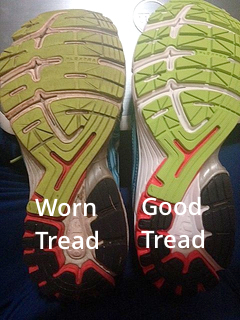When to replace your running shoes (part 3)
Checking the wear pattern on BOTH of your running shoes FREQUENTLY is very important. We recommend doing this every two weeks, or about every 50 miles of use.
The pattern of shoe wear can tell you a lot about your running form. In fact, it can explain why you suffer from a running related injury... or better yet, it might predict a running related injury before it happens.
If we look closely at this pair of running shoes, we see a new shoe. and the same model of shoe that has been worn. (both shoes are the right foot shoe). Compare the worn shoe to the new shoe. The wear on this shoe indicates that full leverage of the great toe, was not utilized at the point of toe-off-the-ground. Although, it was not far off. (See the purple line) The ideal line for optimal power during pronation is indicated with the blue line.
NOTE: If you run on asphalt or concrete, your wear pattern will be easier to see than if you do most of your running on softer surfaces.
It is best to launch from the ground into your next stride with the great toe, leading the charge! Some folks call the "Great Toe" their "Big Toe". Utilizing the leverage of the great toe, you'll get a lot more power out of each stride, and your foot will thank you too, because the skeletal structure of the great toe is so much more robust, and can withstand more impact than the smaller toes and metatarsals of the foot.
The process of weight transfer from initial contact with the ground to the lift-off, is called pronation. Everyone pronates. During the pronation process, some runners have issues with over-pronation, and others have supination issues. Both extremes can be the source of reduced efficiency, and possible injury.
At Inside Out Sports, we are trained to assist you with proper shoe selection. Taking our time to look at your stride, and your current running shoes will help us to improve your running experience. When ever possible, it is best to bring in your current running shoes for us to look at. The wear patterns will be the best evidence to consider during the shoe selection process.
Next week we will explain over-pronation and supination, with some examples of associated injuries.



